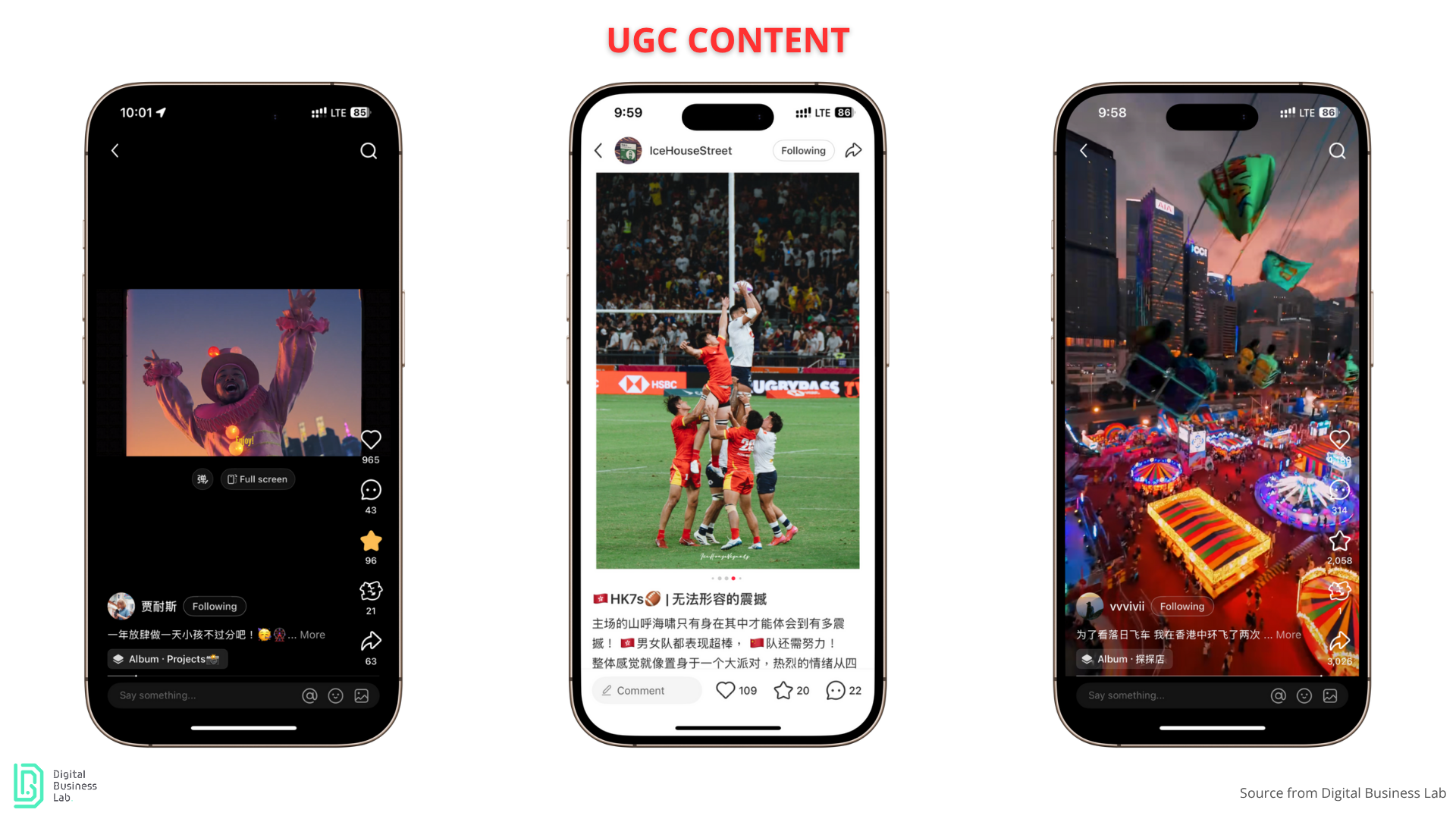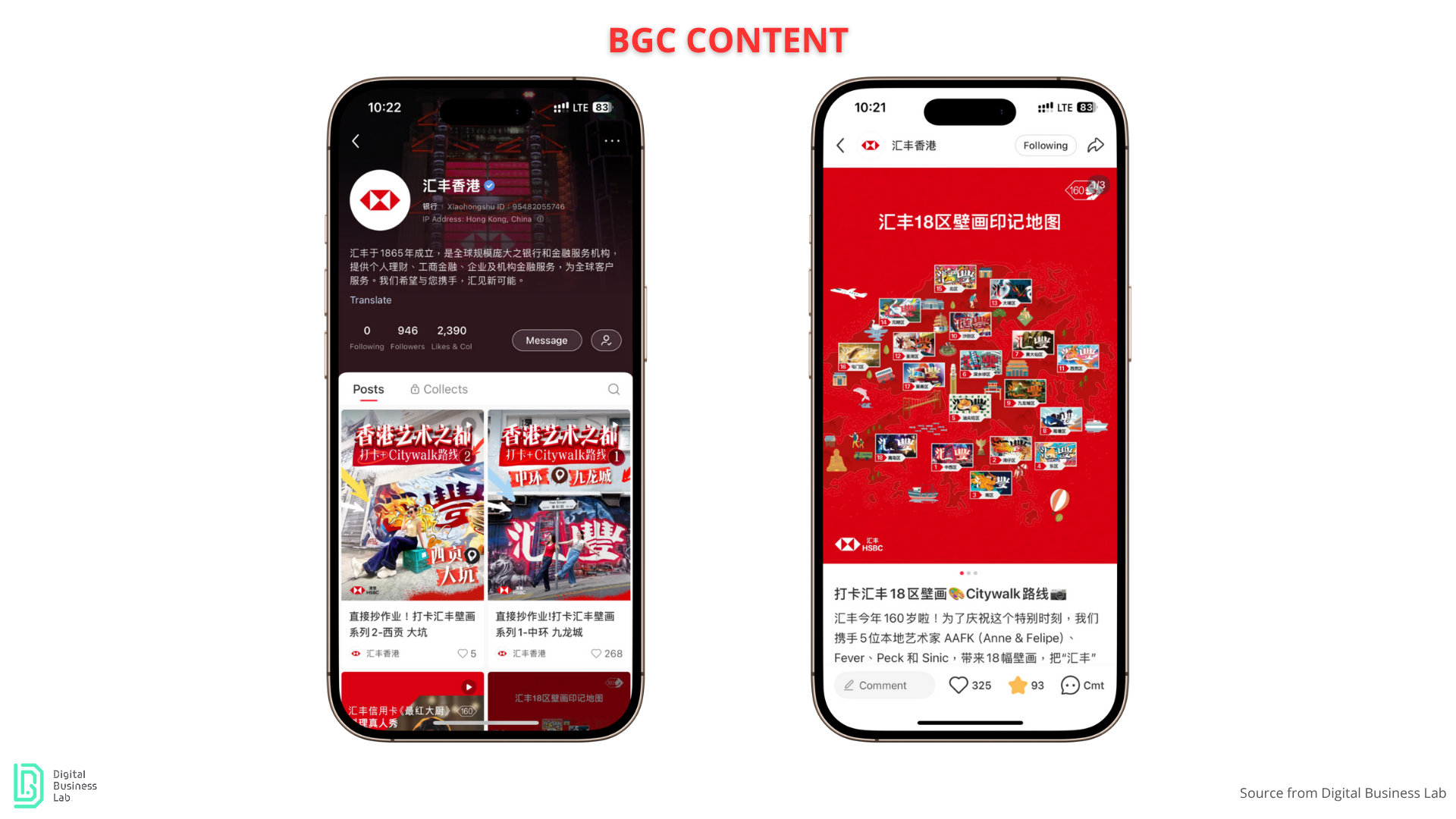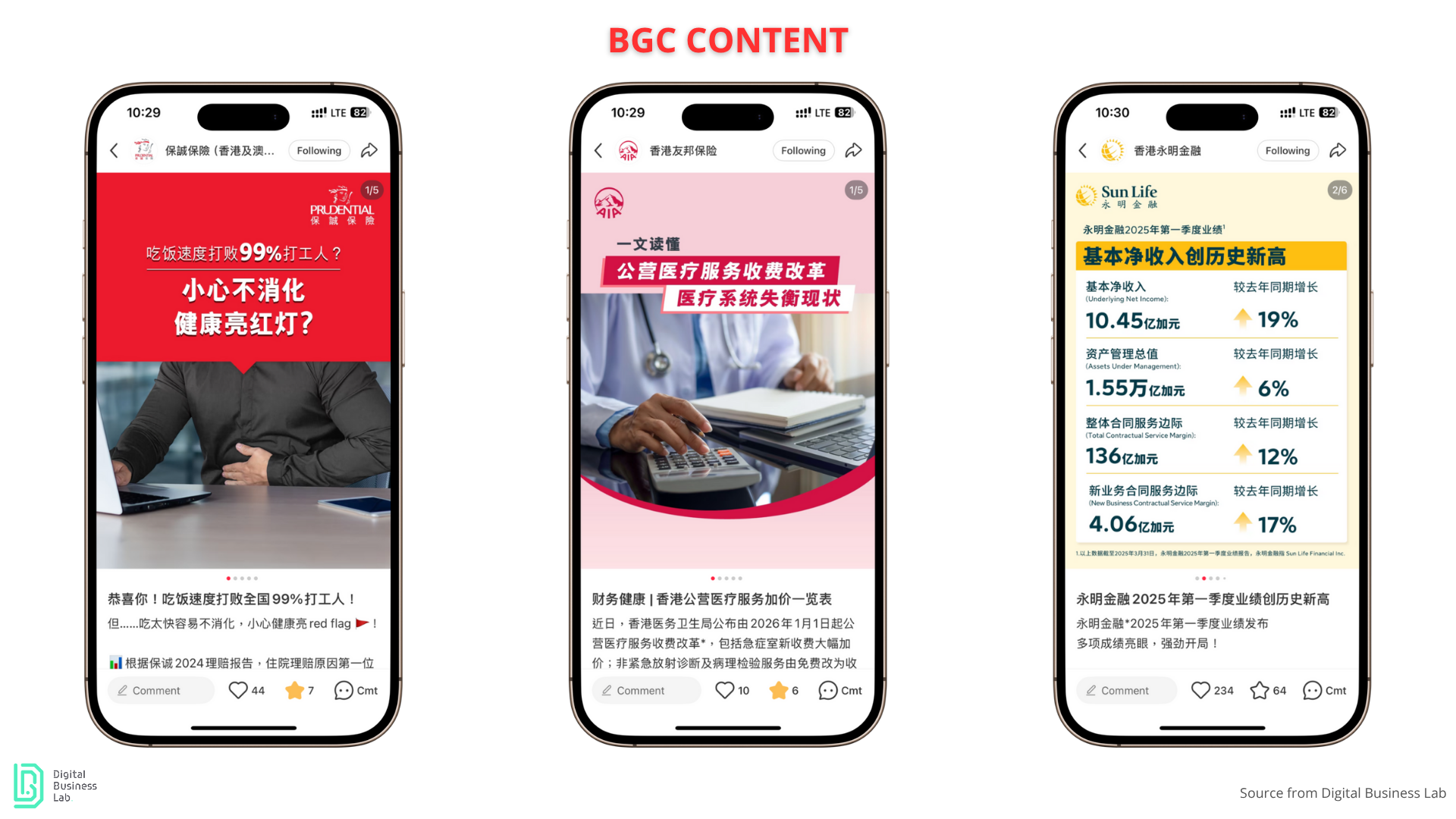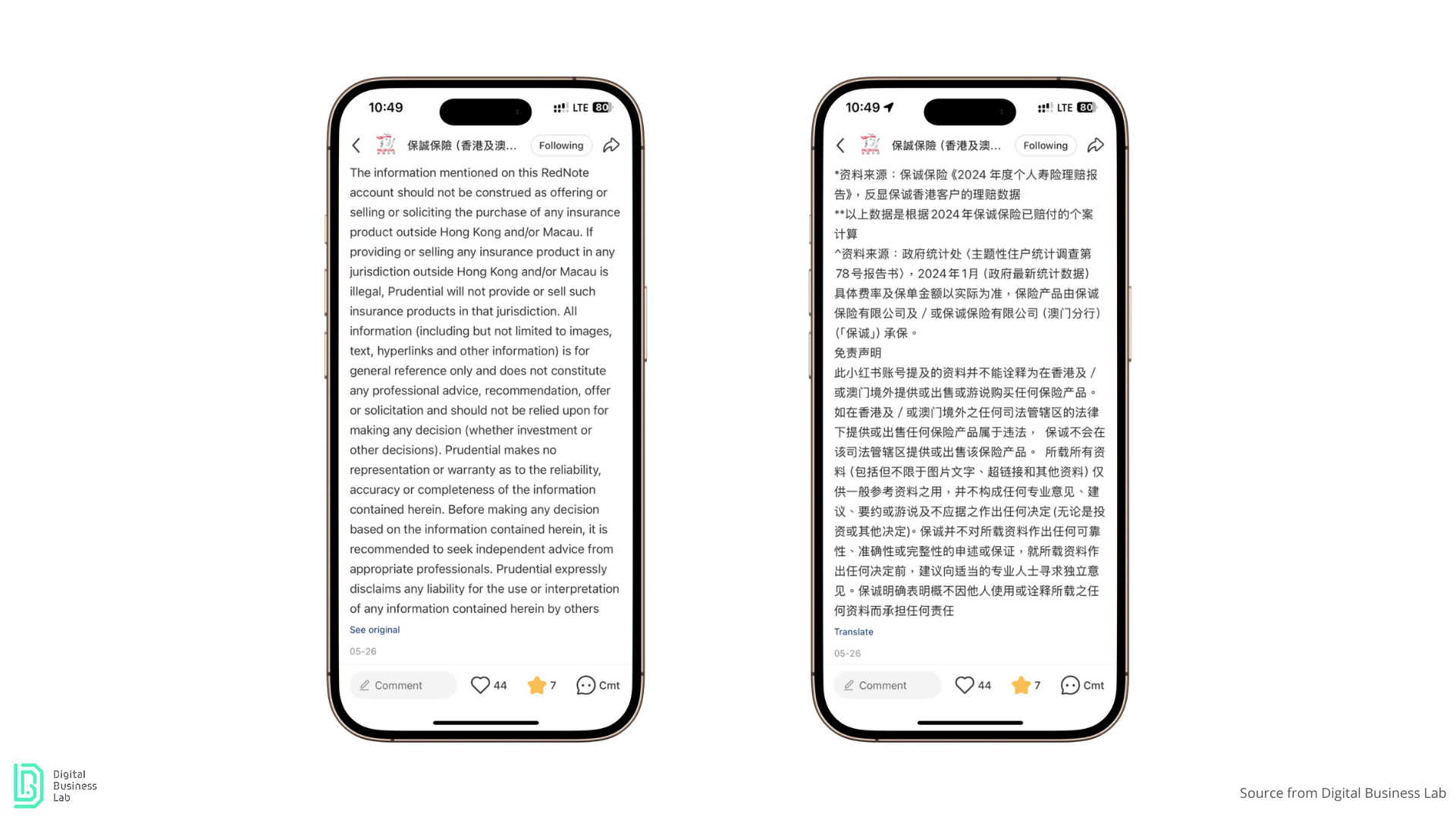Xiaohongshu, often referred to as “Little Red Book” or “RedNote” is making significant progress beyond mainland China, with its official expansion into Hong Kong in June 2025. This move coincides with another pivotal development for the platform. Indeed, as of early 2025, financial institutions, such as banks and insurance companies, are now encouraged to establish official accounts for greater Xiaohongshu presence, albeit with regulated posting guidelines.
This strategic expansion underscores Xiaohongshu’s growing user base and increasing business focus within the region. Leveraging over a decade of social media expertise, our team of specialists, together with our partner Standard Insights, has conducted an extensive survey of over 500 respondents in both the Hong Kong and Singapore markets. The aim was to deeply understand channel penetration and, critically, to explore how marketers in the Finance, Banking, and Insurance sectors can effectively harness these burgeoning platforms.
If you are interested in the results of our survey on the Singapore Market, read our article:
Xiahongshu Marketing: a Singapore Strategic Guide
What to know about Xiaohongshu Users in Hong Kong?
Understanding its Unique Ecosystem
Xiaohongshu is an emerging Chinese social media platform, boasting over 300 million monthly active users in China. Its global appeal surged in 2025 following the US announcement of a TikTok ban, attracting a significant influx of Western users. The platform now offers English language support, complete with post translation features, making it more accessible to a diverse audience. Functionally, Xiaohongshu can be best described as a compelling hybrid: it blends the visual appeal of Instagram, the short-form video dynamism of TikTok, and the community-driven forum capabilities of Reddit. Given the consistent growth of Xiaohongshu’s usage in Hong Kong, our team recognised the necessity of understanding the platform’s current state, growth, and trajectory, which prompted our comprehensive survey.
Check out our previous series of articles on Xiaohongshu:
Little Red Book Marketing: What’s new in 2024 and how brands leverage it? (1/2)
Little Red Book Marketing: What’s new in 2024 and how brands leverage it? (2/2)
Decoding User Usage Patterns
Our comprehensive survey revealed compelling insights into Hong Kong users’ engagement with Xiaohongshu. 58% of our respondents are using Xiaohongshu, and 79% of the non-users considered using Xiaohongshu in the future. This shows an exponential interest in the Chinese platform from Hong Kong users.
A substantial 67% of our sample reported using the platform daily or weekly to actively seek out information related to brands or products. Crucially, this behaviour is predominantly driven by exploration and research, rather than immediate purchase intent. Users leverage Xiaohongshu to delve into a brand’s or financial institution’s identity, understand its values, gauge public perception, and ultimately, assess its trustworthiness.
The Power of Educational Influence
A striking finding from our survey is the pronounced preference among Hong Kong users for practical insights over fleeting trends and promotional content on Xiaohongshu. The emphasis on educational influence has become a significant trend recently, and businesses must integrate this understanding into their strategy when launching their accounts. Rather than focusing on giveaways or attempting to engineer viral campaigns, the emphasis should be on delivering tangible value. This involves empathetically addressing customer pain points and offering authentic, actionable solutions.
Cultivating Genuine Content and Community Trust
Hong Kong Xiaohongshu users exhibit a strong sense of trust within their community. Several survey respondents shared instances of seeking help on the platform, driven by the belief that fellow users provide high-quality answers or that multiple users contribute to comprehensive solutions. This collaborative spirit fosters an environment of shared knowledge and mutual assistance.
The platform’s emphasis on authenticity and community is paramount to building trust and credibility on Xiaohongshu. Users overwhelmingly favour User-Generated Content (UGC) over Brand-Generated Content (BGC) and Key Opinion Leader (KOL) Generated Content. Our survey confirms this, with 52% of respondents indicating a higher trust in content from regular users, compared to 22% for brands and 25.7% for KOLs. This highlights the indispensable role of user-generated content and the credibility of the community itself.
Notably, Xiaohongshu users demonstrate significant creativity in advertising events, with recent Hong Kong examples including posts for the Hong Kong Sevens and the AIA Carnival.

Xiaohongshu Insights for Financial Institutions and Insurances
Banks and insurance companies are now granted permission to establish a presence in Xiaohongshu, subject to specific regulatory conditions. Before delving into the specific do’s and don’ts, our survey gathered valuable data on user perceptions of such financial content.
Current Landscape of Financial Content Interaction
Currently, banking and insurance content are not among the most frequently searched categories on Xiaohongshu, with only 7% of our survey respondents actively looking for this type of information. This could be attributed to overseas banks not yet having a presence on the platform. HSBC Hong Kong, for instance, just launched its official Xiaohongshu account, with its inaugural post celebrating its first anniversary.

However, a significant 74% expressed openness to following these accounts if the content provided includes:
- Easy-to-understand tips (31.9%)
- Educational explainers (26.8%)
- Step-by-step guides (21.5%)
This clearly indicates a disparity between current search behavior and a strong willingness to engage with financial brands. Institutions that proactively invest in delivering valuable financial advice and high-quality educational materials have a unique opportunity to establish a dominant position in this category before competition intensifies.
Financial Education Content as a Conversion Catalyst
When asked what type of Xiaohongshu content would most likely influence them to switch banks or insurers, a substantial majority of respondents cited financial education. While incentives like sports or health rewards held some sway, lifestyle and entertainment perks were largely ineffective in tipping the scales. This underscores the power of informative content in driving deeper engagement and potential conversion within the financial sector.
Insurers from Hong Kong and Macau are actively leveraging the platform to track and engage with emerging trends. For example, AIA Insurance’s Hong Kong account provides valuable insights into medical service pricing adjustments within the region. Similarly, Prudential Hong Kong shares data and analysis on health-related topics and prevalent hospitalization causes in Hong Kong. Meanwhile, SunLife highlights its achievements to underscore its credibility and foster trust.

Posting pitfalls for Finance and Insurance
Given that financial education is highly valued content, this presents a significant advantage for financial institutions, despite Xiaohongshu’s stringent content guidelines for industries like finance and insurance. Banks and insurance companies must adhere meticulously to the following principles:
- Ensure content authenticity: Content must be genuine, accurate, and supported by credible information. Misleading or exaggerated claims are strictly prohibited.
- Comply with regulations: Strict adherence to all relevant laws and regulations, both platform-specific and national, governing financial advertising and product promotion, is crucial. We have noted that financial institutions frequently append a disclaimer to their posts, affirming compliance with platform regulations.
- No direct advertising/hard selling: Direct calls to action such as “buy now” or the sharing of external links (e.g., WeChat IDs, phone numbers) for traffic redirection are generally forbidden. The platform emphasizes “soft-selling” through valuable content that educates and informs.

Strategic Content for Finance and Insurance
The core strategy is to focus on value and education. Xiaohongshu, while not a direct sales channel, cultivates brand trust, educates younger demographics, and positions your institution as a relevant, reliable financial guide. Effective strategies involve providing actionable information, sharing relatable financial experiences, and offering practical advice on financial planning, insurance needs, and investment strategies. Here are some actionable content ideas:
- Implement an education-first Xiaohongshu strategy: Depending on the business’s nature, consider launching educational series such as “Finance 101” carousels or “3 things to know before buying insurance” guides.
- Activate Xiaohongshu regular users as Brand Ambassadors: Recruit and collaborate with everyday users (KOLs) to share their authentic financial journeys, for example, “How I compared three savings accounts” or “Why I picked life insurance over term insurance.” Businesses are also empowering their employees to serve as Key Opinion Sales (KOSs), encouraging them to share insights into their professional and personal lives.
- Utilise Xiaohongshu for Brand Search Optimisation: Users will search for your brand on Xiaohongshu regardless of your presence. Securing a verified brand account allows you to control search results, ensure official content appears prominently above user-generated content, and proactively manage brand perception.
- Address core user questions: Ensure your content directly answers the fundamental questions users are asking on the platform (e.g., “best insurance for Millennials in Hong Kong”).
Financial brands can boost engagement with interactive content, discussions, and Q&A. Audiences are highly receptive when genuine value is offered. It is imperative to view Xiaohongshu as a long-term platform for building trust, rather than a channel for aggressive sales pitches. The goal is to become the go-to financial educator for Gen Z and Millennials (ages 18-44), who comprise 81.2% of the survey respondents.
Key Takeaways for companies launching on Xiaohongshu
- 58% of Hong Kong respondents are already active on Xiaohongshu.
- 79% of non-users are likely to adopt the platform soon.
- Usage is primarily for discovery and research, influencing consumer mindset before purchase.
- Tutorials and reviews are the most highly engaged content types.
- Deals, promotions, and trends rank lowest in user interaction.
- Hong Kong respondents trust content from regular users more than brand or paid influencer content.
Key Takeaways for financial institutions
- Only 7.4% of users actively search for financial content.
- However, 74% would consider following a bank or insurer’s account if the content is interesting or useful.
- Most desired financial content:
- Easy-to-understand financial tips (31.9%)
- Educational explainers (26.8%)
- Step-by-step guides (21.5%)
- The primary reason for switching banks or insurers after engaging with Xiaohongshu content is financial education, not promotions, sponsorships, or entertainment perks.
- This reinforces Xiaohongshu’s role as an educational resource in the financial sector.
Discover projects where Xiaohongshu significantly boosted their impact:
(1) Xiaohongshu Influencer Marketing: Driving Immediate Leads for HK7s in Mainland China
(2) AIA Carnival: Xiaohongshu Influencer Marketing in Hong Kong: Boosting AIA Carnival ticketing
(3) Goyard: Launching their official Xiaohongshu account and repurposing their global content


